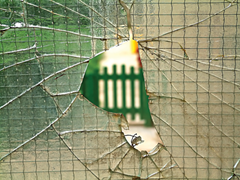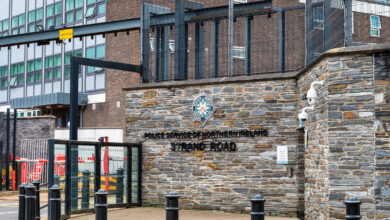Crime rates summary
 The latest figures show a decline in crime, but drug offences are increasing. Stephen Dineen looks at recent trends.
The latest figures show a decline in crime, but drug offences are increasing. Stephen Dineen looks at recent trends.
Crime fell by 2.3 per cent between April-December 2011 compared with the same period in 2010, according to provisional PSNI figures, with decreases across most categories. This follows a 3.8 per cent fall in crime during the 2010-2011 financial year, to the lowest level recorded since new counting rules were introduced in 1998.
Figures for April-December 2011 (compared with April-December 2010) show a drop in robberies of business property (-10.8 per cent), sexual offences (-8.8 per cent) and an 8.4 per cent fall in criminal damage offences. Offences involving interference with a motor vehicle fell by 30.9 per cent.
The figures revealed increases, however, in drug offences (+3.1 per cent), offences of violence against the person (+0.9 per cent) and ‘other’ (non-burglary or vehicle related) theft offences (+7.5 per cent).
Whilst these figures are still provisional, the finalised figures for 2010-2011 showed a 3.8 per cent drop in the number of reported crimes, from 109,139 offences to 105,040, but increases in some categories.
Violence against the person (from murder to minor assaults) offences fell (-1.7 per cent), as did property crimes (-5.1 per cent) and crimes against vehicles (-15.7 per cent).
While the methodology for counting sexual crimes was revised in April 2010 (so historical allegations could be recorded), those offences increased from 1,800 in 2009-2010 to 1,933 during the 2010-2011 period. Murders increased from 18 to 20, while manslaughters doubled from 4 to 8.
In 2010-2011, members of the public constituted 68 per cent of crime victims, 21 per cent were businesses or other organisations, while 7 per cent of crimes were against the state and 4 per cent against police officers. The age group most subjected to crime was 20-24 year olds (14 per cent of crimes, though only 7 per cent of the population). Among those 65 years and over, 90 per cent of crime experienced was property-related, with the remaining crimes being violence against the person (8 per cent) and robbery (2 per cent).
There are considerable differences in the level of crime experienced across Northern Ireland. The lowest crime levels are to be found in the policing areas of Castlereagh, Ballymoney and Magherafelt (rates of 33, 33 and 35 crimes per 1,000 population respectively), while South Belfast, North Belfast and West Belfast are experiencing the highest levels of crime (rates of 181, 101 and 91 crimes per 1,000 population respectively). These three areas have experienced declines in crime over the past five years, as have most of Northern Ireland’s 29 policing areas. Antrim had a higher crime rate in 2010-2011 than five years previous, while East Belfast, despite an improvement in the last two years, had the same level of crime as 2006-2007.
The figures reinforce the findings of the 2010-2011 Northern Ireland Crime Survey which, as expected, found that the province is a safer place to live than England and Wales. The survey, which mirrors that conducted in England and Wales, found that 12.6 per cent of all households and their adult occupants were the victims of crime, compared with 21.5 per cent across the water. While there was an increase in domestic burglary (from a 1.6 per cent to 2.2 per cent prevalence rate) on the previous year, the number of household thefts declined. Forty-four per cent of all crimes measured by the survey (comparable with recordable crimes) were reported to the police.
Long-term view
Trends over the past five years show an overall decline in crime. The crime rate per 1,000 people in the population has fallen, as has violence, property and offences against vehicles (see table). In 2006-2007, for every 1,000 people there were 70 offences reported; in the year ending March 2011 it was down to 58.
In the 2006-2011 period, key trends include:
• a significant drop in violent crimes with injury from 18,094 to 15,156, but a slight increase in the number of violent crimes without injury (+3 per cent);
• an increase in sexual crimes (12 per cent), with offences in the most serious category rising from 1,376 to 1,605;
• a considerable decline in the total number of property crimes (e.g. burglary, offences against vehicles, criminal damage), down 18 per cent, but within this an increase in the number of burglaries;
• less fraud and forgery offences: down to 3,023 from 4,163; and
• an increase in drug crime (+44 per cent), both in trafficking (+60 per cent) and non-trafficking offences (+41 per cent).
In its annual bulletin on crime published last June, the PSNI said that the profile of crime had changed between 1998-1999 and 2010-2011. Violence against the person, sexual offences and robbery had increased from 20 per cent of all recorded crime to 31 per cent, while property crime had fallen from 78 per cent to 62 per cent.
PSNI figures show a gradual rise in sanction detection rates over the past five years i.e. where an offender receives a formal sanction; this is the most suitable measurement of detection to use for long-term trends. In 2006-2007, 19.6 per cent of crimes reported were detected. In 2010-2011 it was 27.3 per cent. The detection rate has risen for most categories of offences, with 12.5 per cent more violence against the person offences detected in 2010-2011 compared to five years previously; a slight increase in the number of sexual offences detected (+2.2 per cent); and a significant increase in detection of fraud and forgery, from 20 per cent to 33 per cent of cases.
Percentage of crimes reported to the police (by type)
| Office Category | 2009-2010 (%) | 2010-2011 (1%) |
| Drug | 81 | 83 |
| Violence against the person | 36 | 39 |
| Fraud and forgery | 24 | 33 |
| Sexual | 21 | 22 |
| Robbery | 19 | 20 |
| Offences against vehicles | 13 | 15 |
| Criminal damage | 12 | 13 |
| Burglary | 11 | 11 |
| All | 26 | 27 |
Crimes rates per 1,000 population
Report sponsored by G4S






